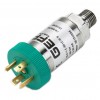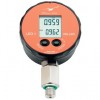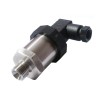The following calculation shows you how you can convert any value in megapascals to kilogrammes force/sq cm:
- 1 kgf/cm² = 98,066.5 Pascals (Pa)
- 1 MPa = 1,000,000 Pascals (Pa)
- kgf/cm² value x 98,066.5 Pa = MPa value x 1,000,000 Pa
- kgf/cm² value = MPa value x 10.1972
MPa pressure related products
 600 bar, 9000 psi, 60 MPa Pressure Sensors, Transducers & Transmitters
600 bar, 9000 psi, 60 MPa Pressure Sensors, Transducers & Transmitters 350 bar, 5000 psi, 35 MPa Pressure Sensors, Transducers & Transmitters
350 bar, 5000 psi, 35 MPa Pressure Sensors, Transducers & Transmitters 700 bar, 10000 psi, 70 MPa Pressure Sensors, Transducers & Transmitters
700 bar, 10000 psi, 70 MPa Pressure Sensors, Transducers & Transmitters 1000 bar, 15000 psi, 100 MPa Pressure Gauges, Meters & Manometers
1000 bar, 15000 psi, 100 MPa Pressure Gauges, Meters & Manometers
Request product info for a MPa unit range pressure measurement device.
Enter a pressure in MPa below to convert it to the equivalent pressure in kg/cm².
kg/cm² pressure related products
 -760mmHg to +20 kg/cm² pressure transmitter with HART coms
-760mmHg to +20 kg/cm² pressure transmitter with HART coms -1 to 20 kg/cm² digital pressure gauge for live computer data acquisition
-1 to 20 kg/cm² digital pressure gauge for live computer data acquisition 20 kg/cm² range 5Vdc output pressure transducer for potable water
20 kg/cm² range 5Vdc output pressure transducer for potable water Diaphragm sealed high temperature pressure transmitter for -1 to 25 kg/cm²
Diaphragm sealed high temperature pressure transmitter for -1 to 25 kg/cm²
Request product info for a kg/cm² unit range pressure measurement device.
Choose a value between 0 and 1000 MPa from the pressure conversion table below, to obtain the converted value in kg/cm².
| MPa | kg/cm² | 🔗 |
|---|
